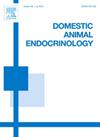母狗发情前期和发情期血清抗勒氏激素浓度与产仔数的相关性研究。
IF 2.1
2区 农林科学
Q2 AGRICULTURE, DAIRY & ANIMAL SCIENCE
引用次数: 0
摘要
抗本文章由计算机程序翻译,如有差异,请以英文原文为准。
Correlation of Anti-Müllerian hormone serum concentration measured in proestrus and estrus with the litter size as a fertility marker in bitches
The use of the anti-Müllerian hormone (AMH) serum concentration as a fertility marker has been shown in cows, sheep and mares and has been indicated in one study in female dogs. The aim of this study was to investigate the connection between the AMH serum concentration, taken at two defined time points during the bitch`s heat, and the litter size to investigate whether AMH can be used as a practical measurement for the individual breeding bitch to predict litter size. The study was carried out on 27 healthy female dogs presented for pre-breeding examination, considering all previously known influencing factors on AMH in the bitch such as age, body weight and estrous cycle phase at the time the sample was taken. Due to the AMH increase in early proestrus and its drop around ovulation, AMH was measured in blood samples taken within the first three days of heat (AMH1) and near ovulation (AMH2) with AMH1 being significantly higher than AMH 2 (p < 0.001). There was a highly significant negative correlation of body weight and AMH at both sampling times (p < 0.001). There were no significant results when the dogs were paired and grouped according to high or low AMH concentrations, but a significant effect of AMH serum concentration on litter size was found in the multifactorial analysis when the dogs were matched according to their body weight (AMH1: p = 0.022; AMH2: p = 0.030). In conclusion, a significant effect of the AMH concentration and the litter size among female dogs with matching body weight could be found, but a much larger sample collection is needed to evaluate reference intervals for AMH for bitches of different weight to predict the fertility of an individual bitch in the future.
求助全文
通过发布文献求助,成功后即可免费获取论文全文。
去求助
来源期刊

Domestic animal endocrinology
农林科学-奶制品与动物科学
CiteScore
5.50
自引率
4.80%
发文量
58
审稿时长
31 days
期刊介绍:
Domestic Animal Endocrinology publishes scientific papers dealing with the study of the endocrine physiology of domestic animal species. Those manuscripts utilizing other species as models for clinical or production problems associated with domestic animals are also welcome.
Topics covered include:
Classical and reproductive endocrinology-
Clinical and applied endocrinology-
Regulation of hormone secretion-
Hormone action-
Molecular biology-
Cytokines-
Growth factors
 求助内容:
求助内容: 应助结果提醒方式:
应助结果提醒方式:


